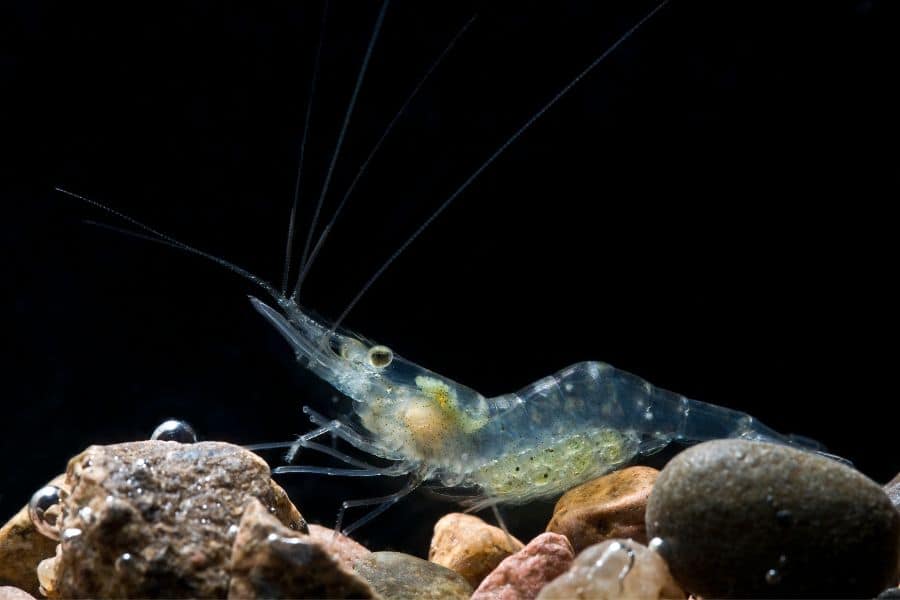Ghost shrimp are a popular and fascinating shrimp species found in many home aquariums. Also known as glass shrimp, these small crustaceans add a lot of interest to your aquatic paradise.
That said, not all beginner fishkeepers know how to properly care for them to ensure a long life. In fact, some aquarists are surprised to find that their ghost shrimp don’t last very long.
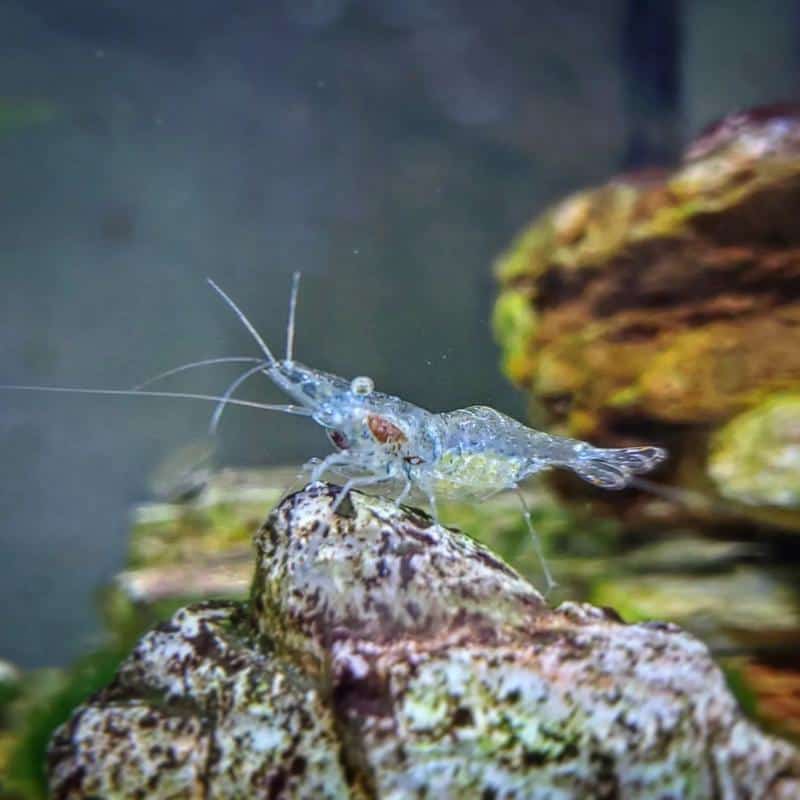
But don’t worry – we want to make sure your ghost shrimp will live a healthy and happy life. In this article, we’ll explore all the essential aspects of ghost shrimp care, from their lifespan and ideal tank conditions to their dietary preferences and potential tank mates.
| Scientific name | Palaemonetes sp. |
| Ease of care | Easy to moderate |
| Temperature range | 67°F to 76°F |
| Temperament | Peaceful |
| pH | 7.0 to 8.0 |
| Lifespan | 1 year |
| Size | 1-2 inches |
| Typical diet | Omnivore, mainly algae |
| Minimum tank size | 5 gallons |
| Ideal tank size | 10 gallons |
| Compatibility | Safe with other species of dwarf shrimp, small, peaceful fish, and invertebrates |
Now that you know the basics, here are five fun facts about ghost shrimp.
- Their bodies are almost translucent: One of the most intriguing aspects of ghost shrimp is their appearance. Their bodies are almost entirely see-through, which allows you to observe their internal organs and even the food they consume as it passes through their digestive system.
- They love burrowing: Ghost shrimp are skilled diggers and natural engineers. A marine species of the ghost shrimp, which are much bigger than the freshwater species we see in aquariums, can even create intricate burrows up to four feet deep that serve as shelter and protection. Of course, aquarium ghost shrimps aren’t as strong as this, but they still do love burrowing in the substrate.
- They’re great algae eaters: Ghost shrimp have a voracious appetite for algae. They’re always grazing on algae, so they’re a fantastic option if you want something that can help keep your tank algae-free. Their constant scavenging also helps reduce excess nutrients in the water, contributing to improved water quality.
- They’re good swimmers: Despite their burrowing tendencies, ghost shrimp are also agile swimmers. They have long, slender bodies and several pairs of delicate, fan-like appendages called swimmerets. These swimmerets enable them to navigate through the water column gracefully.
- They can regenerate lost limbs: Like other shrimp species, ghost shrimp can also regain their lost limbs and even claws through molting. This is an incredible adaptation that contributes to their resilience and survival in the wild.
These intriguing characteristics and behaviors make ghost shrimp a delightful addition to any aquarium, offering aesthetic appeal and an active and engaging presence within your aquatic ecosystem.
Ghost Shrimp Origins
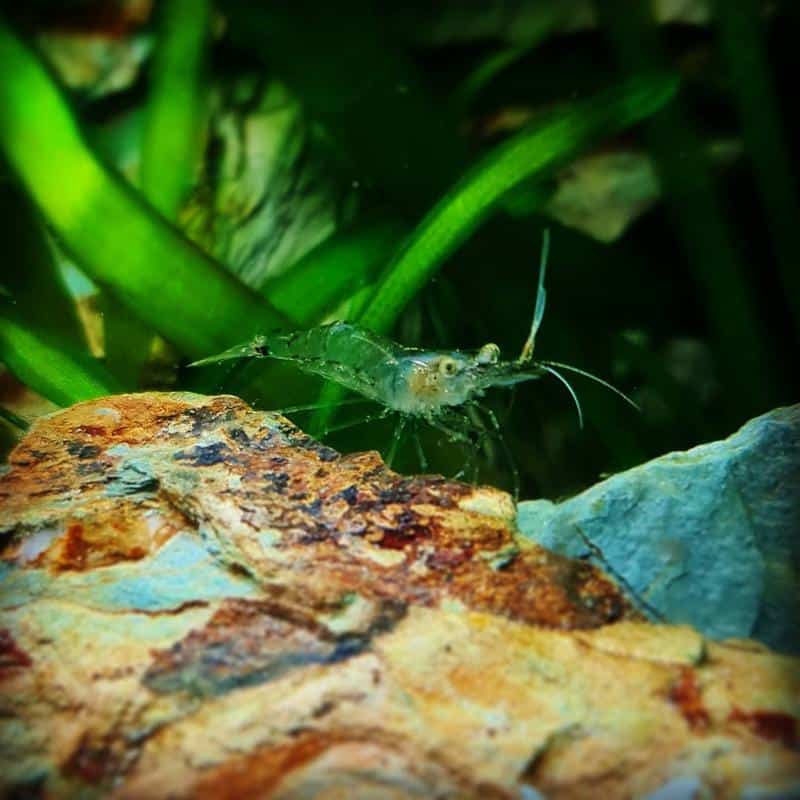
Ghost shrimp, also referred to as glass shrimp or grass shrimp, belong to the genus Palaemonetes, which comprises several species, such as the Palaemon paludosus and Palaemonetes argentinus.
Additionally, the term “ghost shrimp” is used to refer to at least three different genera of shrimps, including the marine species we talked about above.
The exact origins of ghost shrimp are difficult to pinpoint as they are widely distributed across different regions. Due to their ability to tolerate various conditions, they’ve been able to establish populations in many areas beyond their native range.
However, they’re often seen in freshwater and brackish water habitats in North and South America, particularly rivers, streams, marshes, and ponds. Palaemon paludosus is more common in the Appalachian areas, the Atlantic coastal plains, and the Gulf coastal plains in the United States, while Palaemonetes argentinus is more common in South American countries.
The rest are scattered throughout various continents except for Antartica, and their presence is a good bio-indicator for the environment.
Over time, ghost shrimp gained popularity among aquarium enthusiasts due to their unique appearance and interesting behaviors. As a result, more aquarists began to breed them and propagate them in captivity, leading to their widespread availability in the aquarium trade.
Ghost shrimp are now commonly found in home aquariums worldwide, enjoyed for their transparent beauty and helpful role in maintaining a clean and balanced aquatic environment.
Ghost Shrimp Appearance
Ghost shrimp have a pretty distinct appearance. Here’s a quick overview of what they look like.
- Coloration: Ghost shrimp have a nearly transparent or glass-like body. They may have little brownish or greenish dots here and there, but they’re not really noticeable at first glance. What really stands out is their unique and ethereal appearance in the tank.
- Antenna: Ghost shrimp have four long and delicate antennae that extend from the front of their head. These antennae are used for sensory perception, helping them navigate their environment and detect food.
- Rostrum: The rostrum is a spine-like structure located between the eyes of the shrimp that gives them a distinct look. Functionally, shrimps use them to protect themselves from potential predators and detect movement in their surroundings.
- Eyes: Ghost shrimp have eyestalks that extend from either side of their rostrum. They can manipulate and move these eyestalks independently, allowing them to observe their surroundings without moving their body.
- Legs: Ghost shrimp feature several pairs of walking legs, typically five pairs, which are attached to their thorax. These legs, called pereopods, are used for movement, scavenging, and sometimes for grooming.
- Swimmerets: In addition to their walking legs, they also have five pairs of swimming legs called pleopods. Located at the underside of their abdomen, these swimmerets are used for swimming, creating water currents, and in the case of males, for reproduction.
Female vs. Male Ghost Shrimp
Male and female ghost shrimp are sexually dimorphic, which means they have different characteristics that make them easily distinguishable from one another.
That said, while possible, it’s not easy, particularly if you’re a beginner in this hobby. It’s also virtually impossible until they’re about 2-3 months of age since they need to be big enough for these characteristics to show.
Still, here are some general characteristics that can help you distinguish these two.
- Size: Males are generally smaller than females.
- Body shape: Males often have a more slender and streamlined body compared to females, who have a wider, more curvy body.
- Belly shape: Females have a broader and more rounded belly than males, who have straight bellies.
- Saddle: Males don’t have the clear, green-colored saddle that females have. This saddle is used to house their unfertilized eggs.
- Temperament: Male and female ghost shrimp generally have different temperaments. Males tend to be more aggressive, restless, and outgoing, while females are more peaceful and even skittish, preferring to hide instead.
Ghost Shrimp Size
Male ghost shrimp can reach around 1-1.5 inches as adults, while female ghost shrimp are slightly bigger at 1.5-2 inches.
Newly hatched shrimp are tiny and almost transparent, measuring only a few millimeters in length. Juveniles are typically around 1 inch, but as they undergo more molts, they’ll gradually increase in size until they reach their adult size.
Ghost Shrimp Lifespan
Sadly, ghost shrimp have rather short lifespans. They only live in a freshwater aquarium for about a year or so, with many dying before they even reach this age.
Additionally, it’s not unusual for ghost shrimps to pass away within hours or days of being transferred to their new tank. This is usually due to the shock of the transfer, incorrect water chemistry, or an unsuitable tank environment.
It’s important to remember that ghost shrimp are typically labeled as “feeders” by fish stores, so they’re often not given the best care or nutrition, which can affect their lifespan. In fact, they’re often kept in tanks that are too small and have poor filtration and water quality.
Luckily, if you keep them in suitable conditions and are willing to put in the work for your aquarium maintenance, you can help them live longer and happier lives in captivity.
Ghost Shrimp Temperament
Ghosty shrimp are generally considered non-aggressive, making them suitable tankmates for various aquarium fish species.
They usually go about their day scavenging for uneaten fish food or burrowing in the substrate. If you have a planted tank, they may also spend some time among your aquatic plants, munching on any algae that may have developed.
Additionally, they’re quite social creatures and are notable for forming small communities. Some may display minor territorial behaviors or occasional interactions with tankmates, but these are usually harmless and can include minor chasing or jostling over food or shelter.
That said, male ghost shrimp may occasionally get into fights with each other, especially if there are too many males in a small tank. They may also become more aggressive when the females start to lay their eggs, so it’s important to keep an eye out for any signs of aggression.
Also, since they’re scavengers, you can expect them to munch on dead fish or snails. There’s nothing to worry about, though, as this is completely normal behavior.
Ghost Shrimp Molting
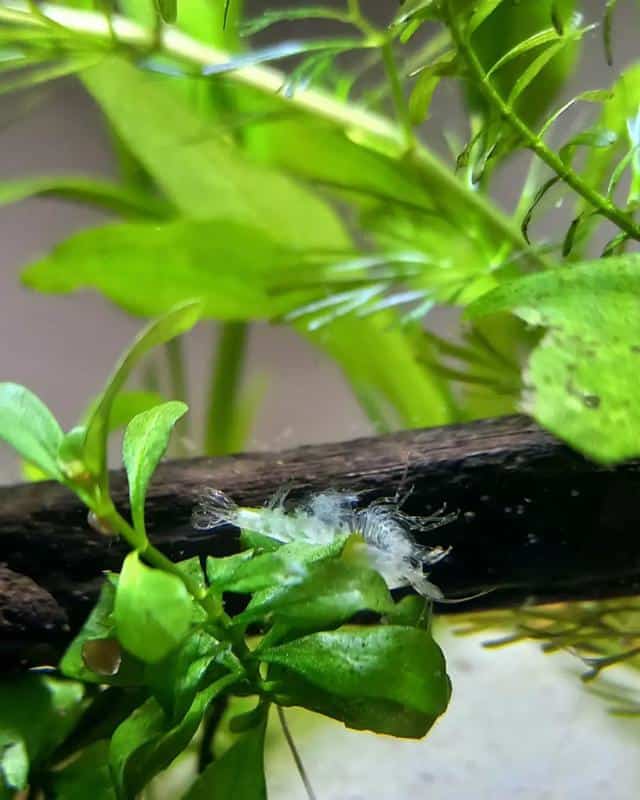
Molting is a natural process in the life cycle of ghost shrimp and many other crustaceans. It’s when they shed their outer shell, called the exoskeleton, in order to allow themselves to grow and develop.
Here’s an overview of what happens during the molting process.
- Pre-molting: Prior to molting, you may notice some behavioral changes in your ghost shrimp, which include reduced activity or decreased appetite. It may also seem more plump than usual due to the water it absorbed as preparation for the molt.
- During molting: Once it’s ready, it will find a secure hiding place. It will then begin to wriggle and twist its body to loosen the old shell from its body. Eventually, the shrimp pulls its body out of the old exoskeleton, leaving the empty shell behind.
- Post-molting: This is a very vulnerable time for the shrimp, as their soft shells won’t be able to protect them from injuries. It will likely stay hidden until its new exoskeleton hardens and provides protection.
- Post-molt recovery: The new exoskeleton starts as a thin, flexible layer and gradually hardens over time. After it fully hardens, the shrimp will feel safe enough to resume normal activities, such as feeding, burrowing, and scavenging.
How Often Do Ghost Shrimp Molt?
Ghost shrimp molt periodically throughout their lives, and the frequency of molting can vary depending on factors such as age, growth rate, and environmental conditions.
On average, ghost shrimp molt approximately once every three to five weeks, although this can vary among individuals.
Younger ghost shrimp, especially juveniles, tend to molt more frequently than adults as they experience more rapid growth. This can be anywhere from once a week to once every two weeks.
As they mature and reach their adult size, the frequency of molting may decrease. However, individual shrimp may still have their own molting schedules.
Problems With Molting
Unfortunately, while molting is a natural process for ghost shrimp, potential problems can arise during this vulnerable stage.
One of these is the “white ring of death,” which is basically a failed molt. As the ghost shrimp tries to get out of its shell, it will often get stuck and be unable to free itself. They will then suffocate or starve because their soft body isn’t able to support their internal organs. Other tankmates can also take advantage and hurt them or worse.
There are many theories as to why the white ring of death happens in shrimp, including poor water conditions, too large or frequent water changes, and malnutrition.
Aside from this, an incomplete molt is also a big issue, as it means your shrimp will stay soft for a longer period of time. The longer your shrimp doesn’t have a hard shell, the more likely they’ll die.
If you want to avoid problems and ensure a successful molt, you need to provide your shrimp with a safe, clean environment and adequate nutrition. The fish tank should have plenty of hiding spaces and vegetation in order to give them a secure spot where they can stay until they fully recover.
Additionally, avoid species of fish that are known to nip fins, as they may not be able to resist nipping at your soft-shelled shrimp.
Ghost Shrimp Tank Size
Ghost shrimp have pretty small tank size requirements. The minimum for ghost shrimp is 5 gallons, and this can be used to house 10-15 shrimps.
That said, providing a larger tank is always beneficial as it offers more swimming and foraging space for the shrimp, promotes better water stability, and allows for a more diverse and stable ecosystem.
Plus, if you want to add other fish as tankmates, you’ll need at least 10 gallons to accommodate them safely. A larger tank reduces the chances of overcrowding, which can lead to stress and potential aggression among ghost shrimp.
How Many Ghost Shrimp per Gallon?
Although some aquarists say that you can keep up to 4 shrimps per gallon, we recommend staying on the safe side: 1-3 shrimps per gallon of water.
That’s because ghost shrimps like foraging, and having too many of them in a small tank will limit their ability to explore and find food. Also, it will make them more likely to get into fights with each other, and you definitely don’t want that.
In other words, overcrowding can lead to stress, aggression, and reduced water quality. It’s always best to err on the side of caution and provide a spacious environment for your shrimp.
Ghost Shrimp Tank Setup
When it comes to ghost shrimp tank setups, it’s best to consider their natural habitat and create an environment that mimics that.
This means a well-planted tank with ample areas for hiding, burrowing, and foraging. The substrate should be fine-grained, like sand or small gravel. Avoid sharp or rough substrates that may harm their delicate little legs.
Ghost shrimp appreciate hiding spots to feel secure and molt comfortably. You can use driftwood, rocks, or PVC pipes to create caves, crevices, and tunnels as aquarium decorations, where shrimp can retreat and where algae can grow.
As for plants, some of the best options are hardy and low-light plants like Java Moss, Java Fern, Anubias, or Marimo Moss Balls. Aquatic grass is another great option. It serves as a grazing area where they can pick up uneaten sinking pellets.
Aside from clean water, ghost shrimp also need plenty of oxygen, which can be achieved by adding a small filter with a gentle flow. You can also use an air stone to increase the oxygen level in the tank.
Ghost Shrimp Care
Like other shrimp species, Ghost shrimp need a healthy environment to thrive. Here are some things to remember when it comes to Ghost shrimp care.
Ghost Shrimp Temperature
The ideal water temperature for ghost shrimp ranges between 67°F and 76°F (19.4°C and 24.4°C), closely mimics their natural habitat. They can also tolerate up to 80°F (26.7°C) for short periods of time, but don’t let them stay in this temperature for too long as it can cause molting problems.
Take note that sudden extreme temperature fluctuations can cause stress and negatively impact their health. Using a reliable aquarium heater and regularly monitoring the water temperature will help maintain the optimal conditions for your ghost shrimp.
Ghost Shrimp Water Parameters
Ghost shrimp prefer their water to be slightly alkaline to neutral. The pH range should stay within 7.0 to 8.0. The general hardness should be between 3 dGH and 10 dGH, while the carbonate hardness should be between 3 dKH and 15 dKH.
You can test the water using API Freshwater Master Test Kit to make sure that you’re hitting all the parameters in the right range.
Ghost Shrimp Diet
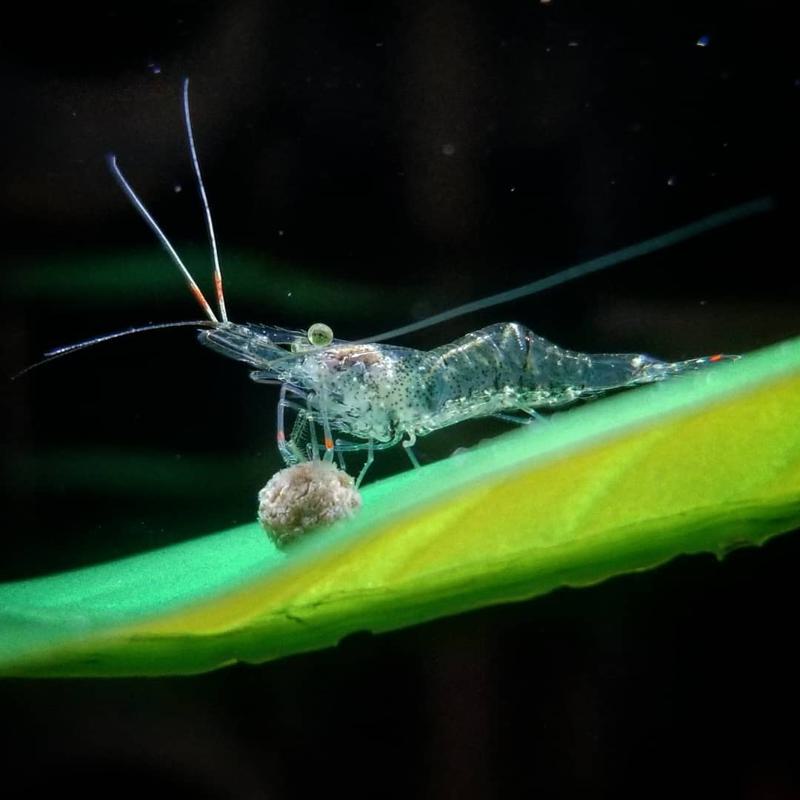
Feeding your ghost shrimp is an important part of their care. Luckily, ghost shrimps can eat a whole range of foods.
Their diet can consist of algae in different forms, such as algae wafers, as well as dead plant matter and detritus.
Ghost shrimp will enthusiastically devour fish or shrimp pellets, fish flakes, and any leftover food in the tank. It can be pretty entertaining watching them swimming up and delicately picking food particles from the water.
A pecking order may be established during feeding, with larger shrimp typically getting the first dibs on the food. Minor fights may also break out – if it gets too much, you can always disturb them by poking a stick inside the tank.
You may also want to supplement their diet with calcium-rich food sources to support healthy shell growth, as calcium is essential for their well-being.
Interestingly, ghost shrimp will also scavenge on deceased tank mates, including dead fish, snails, or other shrimp. It doesn’t hurt to let them feed, but if they don’t finish in one sitting, you should remove the remains to avoid potential ammonia spikes.
Ghost Shrimp Tank Mates
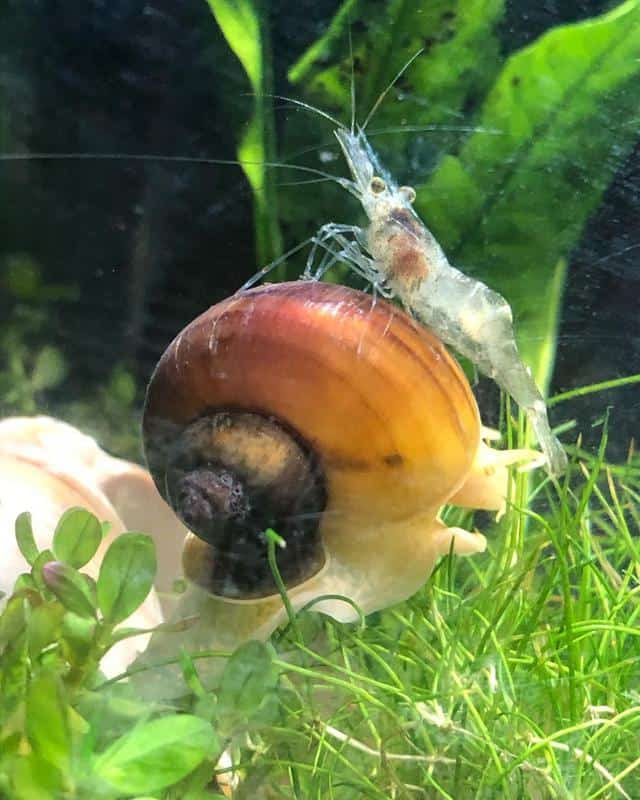
Ghost shrimp can be kept with peaceful, non-aggressive fish species that are not known to prey on or harass them. Larger fish are also likely to view ghost shrimp as a yummy dinner, so stick to smaller species.
That said, even smaller fish that are fin nippers are a no-no for ghost shrimps. Constant picking can hurt or stress out ghost shrimp, and that can lead to their death.
Due to this, suitable tankmates include:
- Tetras
- Zebra Loaches
- Rasboras
- Guppies
- Corydoras
- Endlers Livebearers
- Mystery Snails
- Nerite Snails
Ghost Shrimp Common Diseases
Despite their short lifespan, ghost shrimp are not as fragile as some think. They can tolerate a range of water conditions. Still, this doesn’t mean that they can’t get sick.
Here are some common diseases of ghost shrimp that you should watch out for.
- Fungal Diseases: Fungal infections can occur in ghost shrimp, typically as a result of poor water conditions or injuries. Signs of fungal infections include white cotton-like patches on the body or appendages, lethargy, and loss of appetite.
- Parasitic Infestations: Parasites like fish lice, anchor worms, gill mites, or mermithids can also infect ghost shrimp. These parasites attach to the shrimp’s body or gills, causing irritation, redness, inflammation, and behavioral changes.
- Planaria: Planaria is a type of flatworm that can be fatal to ghost shrimp in certain circumstances. While planaria are generally considered scavengers and not direct predators of adult ghost shrimp, they can become problematic in situations where there is an overpopulation of planaria or when the shrimp are weakened or injured.
- Vorticella: Vorticella is a parasitic infection that can affect all freshwater shrimp species. It’s not really a severe condition, but if it manages to infest the shrimp’s gills, it can obstruct their respiratory system, leading to suffocation and death.
- Muscle Necrosis: Muscle necrosis to the condition in freshwater shrimp where the muscle tissue deteriorates or dies. It’s a serious health issue that can lead to death in ghost shrimp. It can present as discolored, soft, or decaying muscle tissue, eventually leading to a complete loss of muscular function.
How to Prevent Ghost Shrimp Diseases
While it can be very difficult to prevent diseases completely, there are several steps you can take to help keep your ghost shrimp in good health.
- Maintain excellent water quality with proper filtration and regular water changes.
- Provide a well-balanced diet to ensure good nutrition and support the shrimp’s immune system.
- Quarantine new shrimp before introducing them to the main tank to prevent the spread of potential diseases.
- Remove any sick or infected shrimp from the tank to prevent further contamination.
Ghost Shrimp Breeding
Unlike some other shrimp species like Amano shrimp, breeding Ghost shrimp is quite easy. When provided with the right parameters and conditions, Ghost shrimps typically breed on their own.
Here’s everything you need for successful ghost shrimp breeding.
Materials
- Separate 10-gallon tank
- Air pump and filter
- Aquarium light
- Live plants
- Thermometer
- Heater
- Test strips
Instructions
We’ve broken up the stages into three: pre-breeding, breeding, and post-breeding.
- Pre-breeding. First, the ideal breeding tank should have enough space, so we’re recommending a 10-gallon tank. It should also have lots of vegetation and hiding spots to help the female Ghost shrimp feel safe. The aquarium light will help keep your plants stay alive.
- You’ll be using the thermometer to ensure that the tank’s temperature is stable. The ideal temperature for breeding Ghost shrimp is 72°F-78°F (22.2°C-25.6C). If you live in a cold-weather climate, you should have a heater on hand.
- Next, test the water parameters using API Freshwater Master Test Kit. Ghost shrimp need hard, alkaline freshwater, or else they may not breed. Add the filter and pump to keep the water clean.
- Breeding stage. Once the tank is ready, you’ll need to add in the Ghost shrimp. The ideal ratio is one male for every two fertile females. You can fit up to 20 shrimps comfortably in a 10-gallon tank.
- Female Ghost shrimp will lay approximately 20 to 30 eggs every three weeks and carry them for an additional 1-2 weeks. If the male Ghost shrimp successfully fertilizes the eggs, it will take around 3-4 weeks for them to hatch, depending on water conditions.
- If you’re sure that there are already berried or pregnant ghost shrimp, you can take the males and the unberried females back to the original tank.
- Post-breeding. After the eggs have hatched, you’ll need to take care of the shrimplets, or shrimp fry. They’re very tiny and will need microscopic food like infusoria or commercially available shrimp fry food. As they grow, gradually introduce larger food options like baby brine shrimp or crushed flakes.
- Regularly monitor water parameters, conduct partial water changes as needed, and ensure proper filtration and aeration in the babies’ tank. Keep a close eye on their healthy, removing any sick or weak individuals to prevent the spread of disease.
- Baby ghost shrimps become juveniles at 2-3 weeks. You can now move them back to the main tank or rehome them.
Read More:
FAQs
Can Ghost Shrimp Live with Betta Fish?
Bettas won’t eat ghost shrimp, but they may still try to attack them. If you have a peaceful betta, then ghost shrimp should be fine to keep in the same tank. However, if it seems to be aggressive, it’s best to house the ghost shrimp in a separate tank.
How Often Should I Feed Ghost Shrimp?
It would be best if you fed ghost shrimp at least twice or thrice a week, depending on the size of your tank. They usually don’t need to be fed every day, especially if you have a decent size tank with lots of algae potential.
That’s because ghost shrimp are constantly feeding throughout the day. The only time you should consider daily feeding is if you have plenty of them and you have a squeaky clean tank.
Can Ghost Shrimp Live in Saltwater?
Ghost shrimp can’t live in saltwater. They can live in brackish waters, but they can’t survive for long in water with high levels of salinity, as it affects their health, including their transparency. It’s best to keep them in fresh water with a stable pH and temperature range.
Conclusion
As you can see, ghost shrimp are fascinating and low-maintenance additions to any aquarium. Their peaceful nature, efficient scavenging abilities, and intriguing behaviors make them popular among hobbyists.
Whether you’re a beginner or an experienced fishkeeper, the joy of observing these transparent creatures as they gracefully navigate through the aquarium and contribute to the ecosystem is truly rewarding.
With this article, you’re now well-equipped to create an optimal environment for your ghost shrimp, allowing them to thrive and become a captivating addition to your aquatic family!
